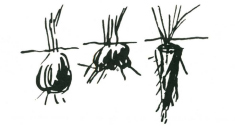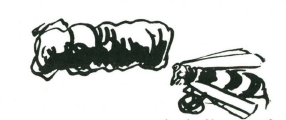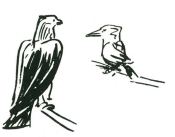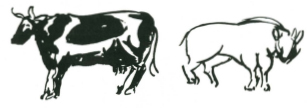Nuts, of course, are seeds, but for this work have been separated into a different section. Many nuts contain hydrocyanic acid poison. This is always detected by the palate, and in nearly all instances where it occurs it can be dissolved by either boiling or soaking in water for 10 to 12 hours. Other nuts, such as the candle nut–a relative of the tung nut–are violent purgatives. Again, cooking either by boiling or baking may render them harmless. Unless you know for certain that the nuts are safe to eat, regard them with some suspicion and test by first tasting, and if taste indicates no poison, then eat a small quantity. If there are no ill-effects within an hour, the nut will be safe.
ROOTS AND TUBERS

Most of the roots and tubers are safe, but almost all must be either boiled or heat treated in some way before they are digestible. The common potato is almost valueless as a food unless cooked.
Yams are not a particular species of plant. The word “yam” simply means the root of a ground vine. The sweet potato is a yam. They are a prolific source of food among people in tropical and sub-tropical regions. There are many vines which have these ground tubers, and, as far as is known, all such tubers are edible if free from the oxylate of lime crystals. In most yams the hydrocyanic poison is water soluble. Although the botanical genus of these tuber-yielding plants will vary greatly, there is one factor in common in the veining system of the leaf. This must not be taken as a hard and fast rule, but it is a very good guiding principle. If the leaf shows that the veins radiate from the point of juncture of the leaf with the stalk, rather than from a main vein, then there may be tubers to be dug from the species of plant.
The tubers and bulbs of many plants are edible, and the simple test of tasting for hydrocyanic acid or oxylates of lime crystal can be applied to all with a fair degree of reliability.
Remember that your own body normally provides you with the safeguards. First is the sight of your food. If it looks healthy and clean, it may be all right. The sense of smell is your next safeguard. If the food smells all right, you apply the next safeguard and taste it. If the taste is all right, the food probably is safe.
The principle of edible foods is as simple as that.
Remember to be careful with nuts and seeds; to regard red as a danger signal; and to avoid the fungi. If you remember these three rules you will undoubtedly be quite safe in testing and eating most plants which are palatable.
WATER
Associated directly with food is water. These two are essential to life. Just as there is the problem of finding food in the bush, so too is there the problem of finding water, and many explorers and backwoodsmen died because they did not know how or where to look for water in apparently dry and arid regions.
Many different forms of life are certain indicators of water in the near vicinity. The bees must have water. The mason fly, that big yellow and black hornet-like creature, requires mud and water for the tunnel wherein he stores the spider he has paralysed. Pigeons and all grain eaters need water, but the flesh-eaters such as the crow and the hawks and eagles can go without water for long periods. By knowing something of the nature of the insects, birds, animals and reptiles you can often find their hidden stores of precious water. (See Chapter 7.)
INSECT INDICATORS OF WATER
BEES
Bees in an area are a certain sign of water. Rarely will you find a hive of wild bees more than three or four miles from fresh water. A bee flies a mile in 12 minutes. You can be sure that if you see bees you are not far from fresh water, but you will probably have to look for further indications before you actually find the water supply.
ANTS
Many of the ants require water, and if you see a steady column of small black ants climbing a tree trunk and disappearing into a hole in a crotch it is highly probable that there will be a hidden reservoir of fresh water stored away there. This can be proved by dipping a long straw or thin thick down the hole into which the ants are going. Obviously if it is wet when you draw it out there is water there. To get the water do not on any account chop into the tree. If the hole is only very small, enlarge it with your knife-point at the top. Make a mop by tying grass or rag to a stick. Dip the mop into the water and squeeze into a pannikin. Another method is to take a long hollow straw and suck the water you require from the reservoir. These natural tree reservoirs are very common in dry areas, and are often kept full by the dew which, condensing on the upper branches of the tree, trickles down into the crotch and so into the reservoir inside the tree. Water reservoirs are very common in the she-oaks (casuarinas) and many species of wattle.

MASON FLIES

These large, hornet-like creatures are a certain indicator of water. If you see a mason fly’s buildings in an area you can be sure that you are within a few hundred yards of a soak of wet earth. Search around carefully and you will see the mason fly hover and then suddenly drop to the ground. If you examine the place where she landed you will find the soil is moist, and that she is busy rolling a tiny pellet of mud for her building. By digging down a few inches (or at most, a couple of feet) you will assuredly find a spring and clear, fresh, drinkable water.

BIRD INDICATORS
FINCHES
All the finches are grain-eaters and water-drinkers. In the dry belts you may see a colony of finches and you can be certain that you are near water, probably a hidden spring or permanent soak.
WILD PIGEONS

Wild pigeons are a reliable indicator of water. Being grain and seed eaters they spend the day out on the plains feeding, and then, with the approach of dusk, make for a waterhole, drink their fill, and fly slowly back to their nesting places.
Their manner of flight tells the experienced bushman the direction of their water supply. If they are flying low and swift they are flying to water, but if their flight is from tree to tree and slow, they are returning from drinking. Being heavy with water, they are vulnerable to birds of prey. It is obvious then that the direction of water can be discovered by observing the pigeons’ manner of flight.
GRAIN EATERS
All the grain eaters and most of the ground feeders require water, so that if you see their tracks on the ground you can be reasonably certain that there is water within a few miles of your location. An exception to this are parrots and cockatoos, which are not regarded as reliable indicators of water.

The carnivores, being flesh eaters, get most of the moisture they require from the flesh of their prey, and consequently are not reliable water-drinkers. Therefore, do not regard the presence of flesh-eating birds as an indicator of water in the area, nor should you regard the water living birds as indicators of fresh or drinkable water.
MAMMALS

Nearly all mammals require water at regular intervals to keep themselves alive. Even the flesh eaters must drink, but animals can travel long distances between drinks, and therefore, unless there is a regular trail you cannot be confident of finding water where you see animals’ trails. This is a general rule. However, certain animals never travel far from water. For example, a fresh track of a wild pig is one sign that there is water in the vicinity, also the fresh track of ‘roos-and most of the grazing animals, whose habit it is to drink regularly at dawn or dusk. In general, water will be found by following these trails downhill.